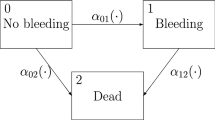Abstract
The consistency of the Aalen—Johansen-derived estimator of state occupation probabilities in non-Markov multi-state settings is studied and established via a new route. This new route is based on interval functions and relies on a close connection between additive and multiplicative transforms of interval functions, which is established. Under certain assumptions, the consistency follows from explicit expressions of the additive and multiplicative transforms related to the transition probabilities as interval functions, which are obtained, in combination with certain censoring and positivity assumptions
Similar content being viewed by others
References
O. O. Aalen and S. Johansen, “An Empirical Transition Matrix for Non-Homogeneous Markov Chains Based on Censored Observations”, Scand. J. Statist. 5 (3), 141–150 (1978).
O. O. Aalen, Ø. Borgan, and H. Fekjær, “Covariate Adjustment of Event Histories Estimated from Markov Chains: The Additive Approach”, Biometrics 57 (4), 993–1001 (2001).
P. K. Andersen, Ø. Borgan, R. D. Gill, and N. Keiding, Statistical Models Based on Counting Processes (Springer-Verlag, New York, 1993).
S. Datta and G. A. Satten, “Validity of the Aalen—Johansen Estimators of Stage Occupation Probabilities and Nelson—Aalen Estimators of Integrated Transition Hazards for non-Markov Models”, Statist. Probab. Lett. 55 (4), 403–411 (2001).
R. M. Dudley and R. Norvaiša, Concrete Functional Calculus (Springer, New York, 2011).
R. D. Gill and S. Johansen, “A Survey of Product-Integration with a View toward Application in Survival Analysis”, Ann. Statist. 18 (4), 1501–1555 (1990).
D. V. Glidden, “Robust Inference for Event Probabilities with Non-Markov Event Data”, Biometrics, 58 (2), 361–368 (2002).
P. Jepsen, H. Vilstrup, and P. K. Andersen, “The Clinical Course of Cirrhosis: the Importance of Multistate Models and Competing Risks Analysis”, Hepatology 62 (1), 292–302 (2015).
N. Keiding, J. P. Klein, and M. M. Horowitz, “Multi-State Models and Outcome Prediction in Bone Marrow Transplantation”, Statistics in Medicine 20 (12), 1871–1885 (2001).
M. Overgaard, “Counting Processes in p-Variation with Applications to Recurrent Events”, https://arxiv.org/abs/1903.04296, unpublished manuscript (2019).
M. Overgaard and S. N. Hansen, “On the Assumption of Independent Right Censoring”, https://arxiv.org/abs/1905.02508, unpublished manuscript (2019).
H. Putter, M. Fiocco, and R. B. Geskus, “Tutorial in Biostatistics: Competing Risks and Multi-State Models”, Statistics in Medicine 26 (11), 2389–2430 (2007).
Acknowledgments
The author would like to thank Erik Thorlund Parner and Jan Pedersen for discussions and comments on drafts of this paper.
This research is supported by the Novo Nordisk Foundation, grant NNF17OC0028276.
Author information
Authors and Affiliations
Corresponding author
About this article
Cite this article
Overgaard, M. State Occupation Probabilities in Non-Markov Models. Math. Meth. Stat. 28, 279–290 (2019). https://doi.org/10.3103/S1066530719040033
Received:
Accepted:
Published:
Issue Date:
DOI: https://doi.org/10.3103/S1066530719040033




